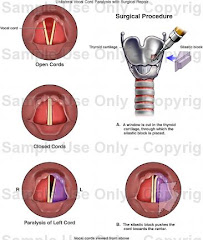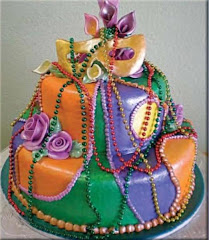
Tuesday, December 1, 2009
Vold Fold Paralysis Summary

Thursday, October 22, 2009
The Adjustable Layngeal Implant
 A modifiable laryngeal implant made of titanium has been developed for the treatment of unilateral vocal fold paralysis. The implant includes three parts: a plate that allows fixation to the thyroid cartilage, a block of titanium which includes the adjustable part, and a micrometric screw in the middle of the lateral side of the block, which moves the adjustable part. Defined medialization is accomplished by modifiable the screw which also allow easy secondary adjustments. This retrospective study assesses clinical outcomes of medialization laryngoplasty with the titanium changeable implant, in patients with unilateral vocal fold paralysis. This study has the boundaries of a retrospective study. However, prelude outcome are hopeful. Examination of one-sided responses confirmed marked growth in laryngeal function, speech, and swallowing. The adjustable laryngeal implant has many advantages including: precise medialization, ease of secondary adjustment, and perseveration of the mucosal wave.
A modifiable laryngeal implant made of titanium has been developed for the treatment of unilateral vocal fold paralysis. The implant includes three parts: a plate that allows fixation to the thyroid cartilage, a block of titanium which includes the adjustable part, and a micrometric screw in the middle of the lateral side of the block, which moves the adjustable part. Defined medialization is accomplished by modifiable the screw which also allow easy secondary adjustments. This retrospective study assesses clinical outcomes of medialization laryngoplasty with the titanium changeable implant, in patients with unilateral vocal fold paralysis. This study has the boundaries of a retrospective study. However, prelude outcome are hopeful. Examination of one-sided responses confirmed marked growth in laryngeal function, speech, and swallowing. The adjustable laryngeal implant has many advantages including: precise medialization, ease of secondary adjustment, and perseveration of the mucosal wave.Journal of Voice, Volume 15, Issue 1, March 2001, Pages 141-150Carole M. Dean, Christian Ahmarani, Maurice Bettez, Reinhardt J. Heuer
Vocal Fold Paresis and Paralysis
 Identification and treatment of the motionless vocal fold are challenging for the otolaryngologist. True paralysis and paresis result from vocal fold denervation secondary to injury to the laryngeal. Vocal fold paresis or paralysis may be unilateral or bilateral, central or marginal and it may engage the frequent laryngeal nerve, superior laryngeal nerve, or both. The physician's first job in any case of vocal fold paresis or paralysis is to verify the finding and be sure that the laryngeal activity impairment is not caused by arytenoid cartilage dislocation or subluxation, cricoarytenoid arthritis or ankylosis, neoplasm, or other mechanical causes.
Identification and treatment of the motionless vocal fold are challenging for the otolaryngologist. True paralysis and paresis result from vocal fold denervation secondary to injury to the laryngeal. Vocal fold paresis or paralysis may be unilateral or bilateral, central or marginal and it may engage the frequent laryngeal nerve, superior laryngeal nerve, or both. The physician's first job in any case of vocal fold paresis or paralysis is to verify the finding and be sure that the laryngeal activity impairment is not caused by arytenoid cartilage dislocation or subluxation, cricoarytenoid arthritis or ankylosis, neoplasm, or other mechanical causes.With this journal I found it to be extremely educational. It breaks down the information into several different sections that includes treatments, evaluation, anatomy, paralysis in children, etc. For someone who is pretty much clueless to the disorder, this journal will give you a great understanding of the disorder as well as treatments.
Otolaryngologic Clinics of North America, Volume 40, Issue 5, October 2007, Pages 1109-1131Adam D. Rubin, Robert T. Sataloff
Sunday, October 4, 2009
Vocal Folds
 The link to Vocal Fold Paralysis an Paresis is another website that provides with you with information regarding the disorder. It also provides you with a video clip of a person with a paralyzed left vocal fold. It also provides you with a few other pictures to go with the information that is provided.
The link to Vocal Fold Paralysis an Paresis is another website that provides with you with information regarding the disorder. It also provides you with a video clip of a person with a paralyzed left vocal fold. It also provides you with a few other pictures to go with the information that is provided.http://www.ucdvoice.org/paresis.html
Voice Problems
The website gives you a breakdown of understanding the disorder, symptoms, diagnosis, treatments, highlights, and frontiers. It also provides you with a glossary of keys words and pictures so you can have a better and complete understanding of the disorder.
http://www.voiceproblem.org/disorders/paresis/index.asp
Vocal Cord Facts
Vocal cord paresis and paralysis result from deviant nerve involvement to the voice box muscles. Paralysis is the complete disturbance of nerve impulse resulting in no movement of the muscle; Paresis is limited interruption of nerve impulse resulting in frail or peculiar activity of laryngeal muscle(s). Vocal fold movements are an outcome of synchronized spasm of assorted muscles. These muscles are controlled by the brain through a precise set of nerves. The nerves that accept these signals are the: Superior laryngeal nerve (SLN), which carries signals to the cricothyroid muscle, located between the cricoid and thyroid cartilages and the Recurrent laryngeal nerve (RLN) carries signals to different voice box muscles responsible for opening vocal folds (as in breathing, coughing), closing vocal folds for vocal fold vibration during voice use, and closing vocal folds during swallowing. Even with advances in diagnostic technology, physicians are unable to detect the cause in about half of all vocal fold paralyses. These cases are referred to as idiopathic (due to unknown origins). Known reasons for injury can include:
Inadvertent injury during surgery
Complication from endotracheal intubation
Blunt neck or chest trauma
Tumors of the skull base, neck, and chest
Tumors of the skull base, neck, and chest
Symptoms of Vocal Fold Paralysis/Paresis consist of:
Voice changes
Airway problems
Swallowing problems
Determining whether one or both vocal folds are affected is critical in the treatment plan. The two treatment strategies to enhance vocal function are voice therapy, the equivalent of physical therapy for large muscle paresis/paralysis; and phonosurgery, an operation that repositions and/or reshapes the vocal fold(s) to improve voice function.
http://www.entlink.net/HealthInformation/vocalChordParalysis.cfm
Saturday, October 3, 2009
Surgery for Vocal Fold Paralysis
 Treatments for Vocal Fold Paresis may vary depending upon the method the otolaryngologist chooses to try. Voice Therapy is a preferred method to use in hopes of correcting the vocal folds with out surgery. Voice Therapy involves exercises to improve breathing and strenghtening of the cords. Another treatment is by adding bulk to the vocal cords by surgically implanting a silicone block. This will give the cords the extra bulkiness it needs to act as the cords would do normally. After surgery patients still undergo voice therapy which helps to train the vocal cords. Another treatment for bilateral paralyzed vocal cords can be the surgical procedure of tracheotomy. A tracheotomy is a tube that is placed in a person's stoma to help for breathing. Normal breathing is not done through the nose and mouth when a trach is surgically implanted.
Treatments for Vocal Fold Paresis may vary depending upon the method the otolaryngologist chooses to try. Voice Therapy is a preferred method to use in hopes of correcting the vocal folds with out surgery. Voice Therapy involves exercises to improve breathing and strenghtening of the cords. Another treatment is by adding bulk to the vocal cords by surgically implanting a silicone block. This will give the cords the extra bulkiness it needs to act as the cords would do normally. After surgery patients still undergo voice therapy which helps to train the vocal cords. Another treatment for bilateral paralyzed vocal cords can be the surgical procedure of tracheotomy. A tracheotomy is a tube that is placed in a person's stoma to help for breathing. Normal breathing is not done through the nose and mouth when a trach is surgically implanted.http://www.entcolumbia.org/parsurg.html
Blog Archive
100% Creole & Loving It!!!

- Creole Princess
- Hi! Welcome to my blog! I'm Shantell Denise Johnson from Louisiana. I've been living in Fayetteville, NC, since Hurricane Katrina. I enjoy traveling, writing poetry, spending time with family and friends. I am a huge collector of dolphins!!! No kids but I do have two god-children, Cameryn (9 yrs old) and Christopher (15 months), and a toy poodle, Cotton. I'm also the proud aunt of 2 sets of twins that are 20 months apart!! (3 boys and 1 girl) Both of my parents are from Louisiana and Creole. I love my Creole Heritage. Being Creole, to me, is like being in a woven basket that holds everything. In this basket is the vessel of passing from one generation to generation. It is from this basket where I seek and give, where my personal crusaders find, nurtures and moves me toward my path of life. It is within this basket that I find wisdom, integrity, dignity, and compassion. From within that basket, I find what it is like to be Creole. “Laisser les bon temps rouler!”
The Bayou State
New Orleans History







